Traditionally the European Union is a region where waste management, circular economy models etc. are highly important policies and governments and private entities had been known to invest heavily in establishing and developing effective waste management programs through recycling, reuse or other. European Union has also set itself some of the most ambitious recycling targets, in the face of the Europe 2020 initiative for example.
The message from the EU’s waste management industry
 The signals coming from the European Union’s waste management sector of the industry is loud and clear – it won’t work unless something is done. Here are some of the key issues voiced out by industry specialists and analysts engaged in the matter:
The signals coming from the European Union’s waste management sector of the industry is loud and clear – it won’t work unless something is done. Here are some of the key issues voiced out by industry specialists and analysts engaged in the matter:
- Higher future targets for resource recovery are simply unrealistic and will not achieved unless backed by fiscal measures;
- There is no point trying to push for fiscal measures in order to achieve set targets (for the EU as a whole) as fiscal measures are either adopted or not, by individual member states, on a national level;
- A EU wide carbon dioxide tax must be adopted by all member states if many of the set goals are actually to be achieved (EC is planning to raise the recycling and reuse rate for the entire union from 50% to 70% – some say the figure is simply impossible to attain as things are now).
Some other issues that need addressing on EU level
- Phasing out landfills – a common policy and practice imposed on all member states by the EU government in order to increase recycling efforts. This however leaves a gap in preventing illegal rubbish dumping.
- Banning landfills as means of waste disposal without a (financially) viable alternative will cause chaos as waste will always go to the cheapest disposal site.
- Transfer of waste from one country to another in EU should be encouraged as this will allow for waste to be processed in the cheapest most effective way (as opposed to simply ending up in a local landfill).
Addressing the organic and food waste recycling issue
It is unbelievable how much food is wasted in the EU every year. Food waste is not usually seen as a problem, and is rarely addressed in discussions and policy making. Recycling of organic waste is also a problem, especially for the United Kingdom. Dealing with these particular waste management problems can be done effectively on a national level. This will not only physically reduce the amount of organic and food waste, but actually develop the national recycling and waste management industry – which creates jobs and GDP, both much needed in many EU member states.
A well-developed recycling and waste management industry will be a step toward the much needed and anticipated complete circular economy – a vision which is starting to be lost on many people. Cultural and regional bad habits of various EU member states should also be dealt with. Excess consumption of plastics in France and Italy for instance is something which can be regulated. There are many other areas due for improvement if the EU’s waste management industry is to reach set goals.
Green living and sustainable households and workplaces are very achievable concepts. Doing a little bit for the environment is not as hard as it may seem, and there are many other things homes and offices can do besides separate rubbish removal in order to reduce their carbon footprint. Here are some simple but effective ways to do this, courtesy of Cambridge University, UK.
Chargers
 Mobile phone chargers, laptop and device docking stations, as well as various printers/scanners/copiers use electricity regardless of whether they are working or not. As long as the plug is in the socket many of these devices will consume some energy as the power plug contains a part called voltage transformer which drains power constantly. Unplug when not in use!
Mobile phone chargers, laptop and device docking stations, as well as various printers/scanners/copiers use electricity regardless of whether they are working or not. As long as the plug is in the socket many of these devices will consume some energy as the power plug contains a part called voltage transformer which drains power constantly. Unplug when not in use!
A mere 5% of power used by the average mobile phone charger is actually used for charging the phone’s battery. The other 95% of power are wasted when the charger is left plugged in.
Computers
- Reducing computer monitor brightness from 100% to 70% saves up to 20 percent of the overall amount of energy the monitor uses.
- A computer monitor left on overnight, can drain as much electricity as it takes to laser print 500 pages;
- Leaving a computer screen turned on overnight will create enough CO2 emissions to fill up a double decker bus;
- Three LCD computers monitors can be run effectively on the power consumed by one of the old CRT monitors;
One third of all power consumed by a desktop computer is used by the monitor.
Energy consumed by computers left on standby accounts for 10% of all electricity consumed in residential homes, or 1% of the world’s CO2 emissions.
Screensavers do not save energy.
Photocopiers and printers
- If the average printer or photocopier is left running overnight, 365 times, it will generate the same amount of CO2 as driving from Cambridge to Paris and back again;
- If the average printer or photocopier was left running for a whole working day, but it was actually used only for 20% of the time, it would generate about 350 pounds in electricity bills;
Turning off printers and photocopiers overnight will save enough electricity to power a large size flat panel TV and a fridge at once, for the same amount of time.
A photocopier left on overnight uses as much electricity as it takes to copy fifteen hundred A4 pages.
Save electricity by using printers and photocopiers using a low melting point toner. Such devices are 40% more efficient in terms of power consumed and warm up time.
Kettles
Kettles are powerful electrical appliances – heating up a litre of water from fridge temperature to boiling point takes a decent amount of watts. If every person in Britain heated up only as much water as they needed each time i.e. 500ml for 2 cups of tea, instead of 1200ml for one year, the electricity saved would be enough to power all streetlights in the UK for seven months. If the same was done by Cambridge University Staff, the institution would save 80 thousand pounds in electricity bills every year.
Why don’t you use one of the following decoration tricks to alter the ambiance in your dining room and make it cozier and more welcoming?
Mount a shade on your luster
By installing a shade on your luster you will create a conversation piece in your dining room that will attract the attention of your guests. Opt for a shade that is a tone that differs from the wall colours and room features. This way you will add contrast to the room and add to it a more playful touch.
Paint your walls in a stripped pattern
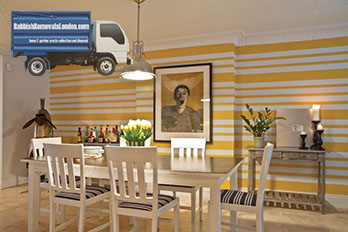 Plain walls can be boring, so instead opt to paint a stripped patter on your dining room walls. It will be up to you to decide how thick to stripes will be. Keep in mind that horizontal stripes will create the illusion that the room is much larger while vertical strips will make your dining room appear taller.
Plain walls can be boring, so instead opt to paint a stripped patter on your dining room walls. It will be up to you to decide how thick to stripes will be. Keep in mind that horizontal stripes will create the illusion that the room is much larger while vertical strips will make your dining room appear taller.
Dress your chairs with slipcovers
Fit your dining room chairs with slipcovers if you don’t have enough funds to replace them with new ones or to change their upholstery. Slipcovers are sold in various colours, sizes and shapes, and can be embroidered with a monogram of your choosing. While it is a cheap remodeling trick it will certainly do the job as it will give a more sophisticated feel to the room.
Covert your ceiling into a decorative feature
Most people forget that their ceiling is their fifth dining room wall. Don’t be like them and add transform your ceiling into a decorative feature by adding architectural elements or painting a unique design. Even more, you can opt to mount vintage wooden beams on your ceiling in order to create a more natural and rustic ambiance. The beams will perfectly compliment the wooden furnishings that you have in the room.
Add supplementary lighting fixtures
While the luster may illuminate the room property it would be much better if you install several additional lighting fixtures such as wall lights or standalone lights, so that you can create a more intimate ambiance when the occasions requires it.
Hang wallpapers
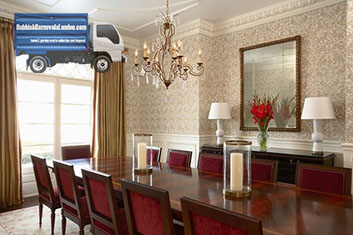 Lots of people neglect the effect that wallpapering can have. Some instead of painting your walls in a neutral or vibrant colour, opt to hang a wallpaper that has an interesting pattern that will showcase your creativity and artistic side. Keep in mind that modern day wallpapering is very easy to mount and maintain in top condition.
Lots of people neglect the effect that wallpapering can have. Some instead of painting your walls in a neutral or vibrant colour, opt to hang a wallpaper that has an interesting pattern that will showcase your creativity and artistic side. Keep in mind that modern day wallpapering is very easy to mount and maintain in top condition.
The decoration of your dining room will certainly generate a certain amount of garbage which you will have to clear before you can enjoy the room. You can delegate the execution of this task to a professional rubbish removal company. This way you will be able to rest after the remodeling project and have the peace of mind that all the garbage is being collected by seasoned rubbish removal experts.
Bonus tip: Add natural elements such as:
- Vase with flowers
- Pots with houseplants
- Bowl with fruits
- Herbarium sets
You are selling your house but the interest towards your property is low! If you are having this problem, keep reading because we will present to you several quick and cheap fixes that will enhance the curb appeal of your house and allow you to sell it more rapidly.
- Paint the front door
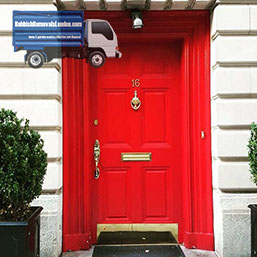 The front door is the first feature of your property that people see during visitations. So apply a fresh layer of paint to not only ameliorate its appearance but also give to your house a more welcoming and cozy touch. The colour is entirely your choice but nowadays people opt for a bright and vibrant ton such as red or yellow as it attracts attention.
The front door is the first feature of your property that people see during visitations. So apply a fresh layer of paint to not only ameliorate its appearance but also give to your house a more welcoming and cozy touch. The colour is entirely your choice but nowadays people opt for a bright and vibrant ton such as red or yellow as it attracts attention.
- Fix your garbage door
The garbage good is as importance as your front door so examine it thoroughly and repair all the dents and cracks that you find. You can also apply a fresh coat of paint in order to enhance the curb appeal of your property.
- Install a new mailbox
 Mailboxes tend to suffer heavily from the natural elements. So as soon as you place the “For Sale” sign you should replace your old mailbox with a new one. This will not only make your property more appealing but it will also reveal to all potential buyers that the house has been property maintained by a responsible owner.
Mailboxes tend to suffer heavily from the natural elements. So as soon as you place the “For Sale” sign you should replace your old mailbox with a new one. This will not only make your property more appealing but it will also reveal to all potential buyers that the house has been property maintained by a responsible owner.
- Check the outdoor lighting fixtures
The more illuminated your property is the more potential buyers will notice it. So, carefully check all your outdoor lighting fixtures and repair the ones that are broken. Also replace all the traditional light bulbs with their eco-friendly counterparts. This will hint to all interested parties that your house is green and more importantly it will slightly elevate its price.
- Refresh your outdoor furnishings
Go through your outdoor furniture and throw away all the furnishings that are too damaged to be repaired or refreshed. The remainder you can restore by either repainting them or changing their old upholstery. Keep in mind that the better looking your outdoor furniture is the more people will notice your house and show a genuine interest in it.
- Remove the rubbish from your property
Your house should be garbage-free before the visitations commence. You can easily clear the accumulate junk by using the services of a professional rubbish removal company. This way you will have the comfort of mind that the job will get done perfectly and that your property will indeed be 100% free of waste. Don’t worry about the price of rubbish removal services as nowadays most companies work with reasonable rates.
- Add potted plants
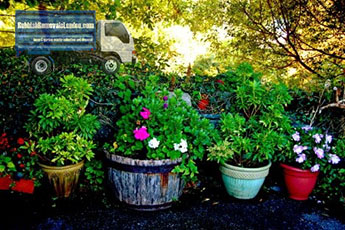 Plain backyard and front lawns are boring and unattractive. So if the green areas of your property lack of bushes and flowers, add pots with colourful plants and flowers. This way you will not only increase the attractiveness of your property but you will also grab the attention on random pedestrians who may turn out to be potential buyers.
Plain backyard and front lawns are boring and unattractive. So if the green areas of your property lack of bushes and flowers, add pots with colourful plants and flowers. This way you will not only increase the attractiveness of your property but you will also grab the attention on random pedestrians who may turn out to be potential buyers.
Efficiency and functionality are very important when it comes to collecting and removing domestic and commercial waste using specialised vehicles. There are different types of rubbish removal vehicles, or trucks as they are commonly known. Each category vehicle has a specific capacity, and utilises a different waste collection technology. The size and capacity of a rubbish removal truck is determined by the type and volume of waste it needs to collect and accommodate. After all there is a huge difference in the rubbish that is collected in an industrial area and the waste cleared in Westminster, for example.
General household and office waste
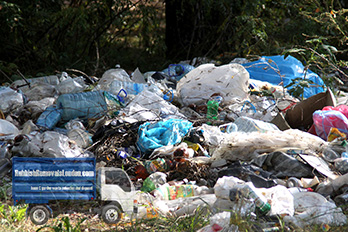 In most cases, general household and office waste is collected in smaller sized rubbish removal vehicles, usually specially fitted vans. In the UK and some parts of Europe, these are called cage vans, or tipper cage vans. Rubbish removal vans used in urban areas can be:
In most cases, general household and office waste is collected in smaller sized rubbish removal vehicles, usually specially fitted vans. In the UK and some parts of Europe, these are called cage vans, or tipper cage vans. Rubbish removal vans used in urban areas can be:
- Short, medium or long wheelbase depending on specific requirements;
- Standard load or heavy duty in regards to their hauling capacity (generally rubbish removal vans vary between 3.5 and 5 tons for heavy duty versions);
- Flat bed, cage or cage tipper – flat top vans are mainly used for rubble and garden waste, cage vans can accommodate bulkier waste and large objects of all kinds, cage tipper vans are fitted with a hydraulic mechanism allowing tipping of waste at disposal sites;
Municipal & industrial solid waste
Collection and disposal of municipal waste on regular basis is usually a service maintained and provided by local authorities or delegated to a specialised waste management service provider licensed and qualified to perform such operations. In this case, the vehicles in use are larger and technologically more advanced than the rubbish removal vans mentioned in the previous section of this article. Specialised rubbish removal and disposal trucks are expensive pieces of machinery and require qualification and training on behalf of their drivers / operators. The main types of rubbish removal trucks utilised around the world are:
- Front loaders – used mainly for industrial waste removal and transportation, front loaders utilise a fork-like device fitted at the front of the vehicle which locks onto, and lifts a large sized solid waste container and then tips its contents in a larger, covered container fitted behind the cabin.
- Rear loaders – used predominantly in residential areas, these trucks are fed rubbish from the back by waste collection technicians. One version of these vehicles is manually fed rubbish bags by staff, the other version features a grab system in order to clamp and tip rubbish bins inside the truck’s waste container.
- Automated side loaders – these are used in many countries, again for servicing residential areas. In this case the truck features a side loading system using hydraulics to lift and tip different size bins (mobile rubbish bins) through an opening, which then feeds garbage into a waste processing (compacting system) inside the vehicle.
- Pneumatic collection vehicles – these trucks suck waste from specially fitted underground containers through a high capacity nozzle.
- Grapple trucks – these vehicles are designed to deal with large volumes of heavy waste as they are fitted with heavy duty grapples able to lift larger amounts of waste in one go. Mainly used for industrial and construction waste removal.
Composting is an eco-friendly way to optimize the waste management and rubbish removal processes in your home. It helps you get rid of junk, but also reduce the overall amount of waste produced by your housed. Understanding the basic principles of composting will definitely help you manage the job better and achieve optimal results, which will be a good thing for you, your home and the planet as well.
- What is compost?
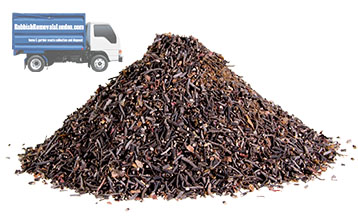 Compost is organic matter that has gone through a process of recycling and turned into fertilizer and/or soil amendment. Compost can be made of leaves as well as food waste. The most basic way in which you can do that is to pile it in a heap and wait for the waste to turn into humus after a couple of weeks to a month’s time. There are several special techniques for making rich compost that involve regulation of the amount of water, carbon, nitrogen and air that are allowed into the compost itself.
Compost is organic matter that has gone through a process of recycling and turned into fertilizer and/or soil amendment. Compost can be made of leaves as well as food waste. The most basic way in which you can do that is to pile it in a heap and wait for the waste to turn into humus after a couple of weeks to a month’s time. There are several special techniques for making rich compost that involve regulation of the amount of water, carbon, nitrogen and air that are allowed into the compost itself.
- What can you compost?
There is a rather rich variety of items that you can put for compost. Those include mainly kitchen waste like spoiled food or leftovers, vegetables, fruits, leaves, branches, plants, eggshells, coffee grounds and filters, paper, and cardboard. Bread, dryer lint, chemically treated wood, used personal items, glass, glossy paper, and grease can also be composted, but the problem is that they are not as eco-friendly as the green materials. Either way, it is much better to compost them than to just throw them away in the garbage.
- Why compost?
There are several very good reasons why you should consider taking up composting. For starters, it is a very eco-friendly approach to waste management. The process reduces the amount of junk that is dumped on a daily basis on landfills and dumpsters. It significantly reduces the negative effects of junk on the environment. It optimizes the way food is being processed in your household, because it finds a viable purpose for food waste that you would otherwise simply throw away. Once the compost is made, you can use it as fertilizer for your garden. No matter whether you are growing vegetables or flowers, it would be much better to make the soil richer via compost, instead of the chemical substances that are usually to be found in commercially produced fertilizers. Last but not least, even though composting might seem a bit complex at first, once you get a grip on the process you are going to realize that it is not that hard at all to do it and contribute to the balance in the environment.
- How to get started?
The first thing to do is to build a compost bin to fill with the items needed for composting. You can put it in the backyard and start collecting junk in it. This will on one hand help you determine how much junk your household is producing, while at the same time you are going to make the whole process much more organized. Many local communities now have community compost bins where residents can collectively accumulate the compost. Check out if yours has such.
Spring is here and there is one thing that you need to do very soon – that is, of course, carry out a spring cleaning at your home. Spring cleaning is not just any other major domestic sanitation job. It is complex and time consuming and rather important too, because it refreshes your home and prepares it for the upcoming warmer, jollier seasons. There are quite a lot of things to do around the house when it has spent several months accumulating clutter and just general chaos – from putting your winter clothes away to clearing out the garage so that you can finally use it for its original purpose – parking the car inside.
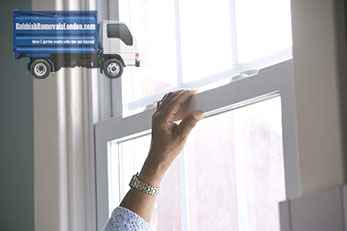 That is why a reliable rubbish removal service, or a properly done DIY clearance is a must in order to have a complete and satisfactory spring cleaning experience.
That is why a reliable rubbish removal service, or a properly done DIY clearance is a must in order to have a complete and satisfactory spring cleaning experience.
Naturally you might be tempted to go around the task of junk hauling on your own so that you can save a little money. Our advice is – don’t. You will end of losing time and even money, because as experience shows, sometimes it is better and cheaper to actually hire someone with the necessary set of skills and equipment to carry out a project. A spring cleaning related rubbish clearance can be quite a burden for the following reasons:
- Too much would be involved into handling the job, time that you most likely do not have
- There is always the risk of injuries and strains that you definitely would much rather avoid
- There would be an added cost because even if you are doing the job on your own, you will still have to hire a truck or a skip
- You will have to handle all the logistics, including finding a recycling depot to bring the trash to for disposal
- The whole process requires skills and knowledge you might not have
All those complications might make you want to turn to a professional to handle your waste clearance, and that would be just the right thing to do. A clearance contractor would provide you with:
- Convenience, because you will not be wasting any time collecting, loading and disposing of the rubbish. Additionally, the whole job would be completed at a schedule that you decide on, e.g. exactly when you want it to
- Safety, because you will not be exposed to any risk of back injuries or any other health concerns. The professionals handling your project would know how to get the job done in a way that will be risk-free.
- Budget-friendly solution. The service will include all charges, including those for the truck or skip, and it would be a very reasonable price for sure.
- Comfort, because you will not have to worry about managing the logistics of the whole thing. The company is going to bring the truck, collect the rubbish and then drive to the nearest depot for disposal and recycling. When you come to think of it, it is a much more-eco friendly solution than anything you have as an option.
The time has come to renovate your kitchen. If you are going to handle your first kitchen remodeling project here are several mistakes that you shouldn’t make.
Forgetting your budget – Decide which are the most important features in your kitchen and allocate an amount that will cover their remodeling. This will not only allow you to learn in advance on what are your financially capabilities but it will also prevent you from spending all your savings. Once you set a budget make sure that you don’t blow it because it may have very unpleasant consequences.
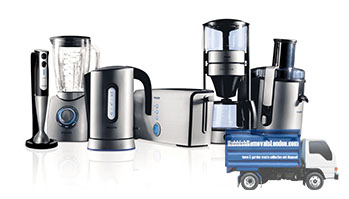 Neglecting the adjacent rooms – You may be renovating your kitchen but this doesn’t mean that the neighbouring rooms won’t be affected by the reconstruction. So make sure that you seal the doors and windows between the rooms in order to keep all the dust, dirt, paint and remodeling debris from penetrating the other rooms and tarnishing them.
Neglecting the adjacent rooms – You may be renovating your kitchen but this doesn’t mean that the neighbouring rooms won’t be affected by the reconstruction. So make sure that you seal the doors and windows between the rooms in order to keep all the dust, dirt, paint and remodeling debris from penetrating the other rooms and tarnishing them.
Choose your appliances first – The colours of your appliances will determine the overall scheme of your kitchen while their size will decide how much space you will have for the countertops and cabinetry. So, if you are planning to replace your kitchen amenities, start your remodeling project by choosing them first.
Cutting counter and storage space – A functional kitchen is a room with plenty of storage and counter space, so never compromise with it. This way you will have enough space to store your food and have an easy access to all your smaller appliances such as:
- Microwave
- Coffee machine
- Electric tea pot
- Mixer
- Meat grinder
Don’t forget the work triangle – Practical kitchens are rooms which have a work triangle which is comprised from the most used items in the area. In most cases these features are the sink, over and refrigerator, so make sure that you arrange these appliances in a triangular layout in order to maximise your time in the kitchen and spare yourself redundant trips between the aforementioned amenities.
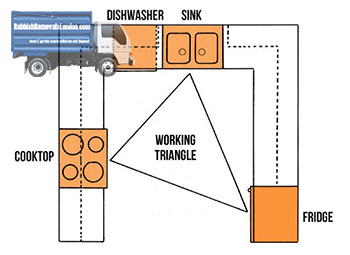 Don’t forget that is a property upgrade – A kitchen renovation is a property upgrade which will certainly increase the value and curb appeal of your household. So, don’t consider the remodeling costs as an expense but as in investment in the future and always go with the best materials, features and appliances that you can afford to purchase.
Don’t forget that is a property upgrade – A kitchen renovation is a property upgrade which will certainly increase the value and curb appeal of your household. So, don’t consider the remodeling costs as an expense but as in investment in the future and always go with the best materials, features and appliances that you can afford to purchase.
Hire professional contractors – All remodeling projects tend to generate a vast amount of builder’s garbage which must be cleared as soon as the renovation is over. Keep in mind that some types of waste can be cleaned only by certified rubbish removal contractors, so instead of handling the job on your own and putting your health at risk, book the services of a junk collection company. Don’t worry about the rubbish removal rates as nowadays most firms work with cost effective and reasonable prices.
Try to have fun – Having a good time is the key of conducting a successful kitchen renovation, so even if it gets hard don’t stop having fun because once you are done you will have a fresh kitchen for you to enjoy.
For 8 years there has been a movement which some people approve and other criticise. It has begun in Estonia and the main purpose is to unite people to clean up their country in just one day. A lot of people joined because it sounds so perfect. But it is up to you to decide whether this event is effective or just makes for a good ad. The positive aspect of this movement is that people are enthusiastic, excited and determined to clean, to ‘save the planet’ when they are not alone. They make maps of areas which need to be cleaned and it’s easier for the good organisation. Of course the end result could be really satisfying, but we should think what causes this emergency need of cleaning, when we all know professionals who have to do this for a living.
 First of all concerns that some of us may have is that when tons of rubbish has been picked up, there has to be very good plan for removing and recycling it. You can’t expect millions of people to clean their cities, parks and neighbourhoods but only the local garbage removals to participate. It’s simply not possible all trash to be transported in one day, so there will be some places with heaps of trash. One day is just not enough if a city has a lot of different problems with pollution. If such events more often are being held, people will have their habits and will prevent the need of cleaning. Because isn’t it duplicity when you clean up because of the new cause and then again create pollution with your actions? It’s only our fault if streets and parks are dirty. That’s why some governments have a lot of laws and penalties for those who throw packages everywhere and don’t keep clean. Probably these countries don’t have to join this ’clean up’, because the citizens know why they pay taxes and fines.
First of all concerns that some of us may have is that when tons of rubbish has been picked up, there has to be very good plan for removing and recycling it. You can’t expect millions of people to clean their cities, parks and neighbourhoods but only the local garbage removals to participate. It’s simply not possible all trash to be transported in one day, so there will be some places with heaps of trash. One day is just not enough if a city has a lot of different problems with pollution. If such events more often are being held, people will have their habits and will prevent the need of cleaning. Because isn’t it duplicity when you clean up because of the new cause and then again create pollution with your actions? It’s only our fault if streets and parks are dirty. That’s why some governments have a lot of laws and penalties for those who throw packages everywhere and don’t keep clean. Probably these countries don’t have to join this ’clean up’, because the citizens know why they pay taxes and fines.
The idea can be really wonderful if it is about abandoned areas, villages or difficult to access mountain regions and rivers. Some places need our help in order to flourish again. There are some places in this world which are worth being visited, but will someone ever be astonished to visit a place decorated with empty bottles and dirtiness? Even worse – some organisms could die, because we disturb their native habitat. For instance if we clean a river bed from old car tires, sticks and other rubbish, we definitely help the creatures that live there, which is essential for the balance of nature. Again it is very crucial for us to know where we should transport rubbish, because nobody wants to clean up one spot and to destroy another. Whatever environmental mission we choose, we have to be sure what is our goal and what means should we use. Sometimes having good intentions is not enough and they have to be translated into well planned actions.
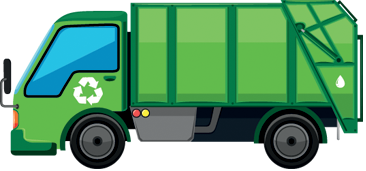

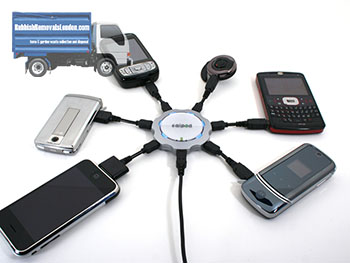 Mobile phone chargers, laptop and device docking stations, as well as various printers/scanners/copiers use electricity regardless of whether they are working or not. As long as the plug is in the socket many of these devices will consume some energy as the power plug contains a part called voltage transformer which drains power constantly. Unplug when not in use!
Mobile phone chargers, laptop and device docking stations, as well as various printers/scanners/copiers use electricity regardless of whether they are working or not. As long as the plug is in the socket many of these devices will consume some energy as the power plug contains a part called voltage transformer which drains power constantly. Unplug when not in use!